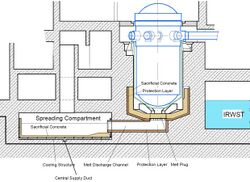Core catcher
Topic: Physics
 From HandWiki - Reading time: 2 min
From HandWiki - Reading time: 2 min
A core catcher is a device provided to catch the molten core material (corium) of a nuclear reactor in case of a nuclear meltdown and prevent it from escaping the containment building.
A core catcher is made from a special concrete ceramic to prevent material from trickling through; it also has a cooling mechanism to cool down the core material.[1][2] The core catcher of the European Pressurized Reactor (EPR) has 170 m² expansion area and a mass of 500 t.[3]
Examples of reactor types with core catchers, besides the EPR, are:
- SNR-300 (fast breeder)[4]
- AES-91 / VVER-1000/428[5]
- VVER-1200(PWR)
- SWR1000 (BWR)
- ESBWR (BWR)
- ABWR (BWR)
- APWR (PWR)
- Atmea I (PWR)[4]
- ACPR-1000 (PWR)
- EU-APR1400 (PWR)
- IPWR-900[6][7]
The AES-91, a project of Atomstroyexport based on the VVER-1000 design, was envisaged to be the first type of nuclear plant to have a core catcher directly underneath the reactor.[8] Thus, in early 2011, the two reactors of the Chinese Tianwan Nuclear Power Plant were the only working nuclear reactors with this type of core catchers.
The Russian physicist who helped design the Russian core-catcher model during the Chernobyl crisis, Leonid Bolshov, has stressed that the experience of Chernobyl has encouraged Russia to create reactors with core-catcher safety devices in new nuclear plants.[9]
In 2018, Rosatom installed a 200-tonne core catcher at Bangladesh's Rooppur 1 Nuclear Power Plant (planned to go into operation in 2023), describing it as "a unique protection system".[10]
References
- ↑ Siempelkamp: Core Catcher - Cooling Structures
- ↑ IAEA-Dokument: Status of Fast Breeder Reactor Development in Germany
- ↑ "Archived copy". Archived from the original on 2012-03-21. https://web.archive.org/web/20120321142815/http://www.siempelkamp.com/fileadmin/media/nuk/corecatcher.pdf. Retrieved 2011-03-19. (Brochure in German, describing the concept of the core catcher for the EPR in Finland)
- ↑ 4.0 4.1 Areva Brochure: EPR - reference number:G-61-V1-07-GER
- ↑ AtomStroyExport News
- ↑ Mohanty, Ajit Kumar (26 January 2020). "Republic Day address of Director, BARC". Bhabha Atomic Research Centre. http://www.barc.gov.in/presentations/20200126.pdf.
- ↑ Annual Report 2018-19, Department of Atomic Energy. Department of Atomic Energy, Government of India. p. Chapter 1, Page 49. https://dae.gov.in/writereaddata/DAR2018-2019.pdf. Retrieved 11 April 2021.
- ↑ WNA - Nuclear Power in Russia
- ↑ [1] (Pulitzer Center for Crisis Reporting and Scientific American)
- ↑ "Core catcher installation under way at Rooppur 1 - World Nuclear News". http://www.world-nuclear-news.org/Articles/Core-catcher-installation-under-way-at-Rooppur-1.
External links
- Under The Hood With Duncan Williams — Core Catching, Duncan Williams
 KSF
KSF
